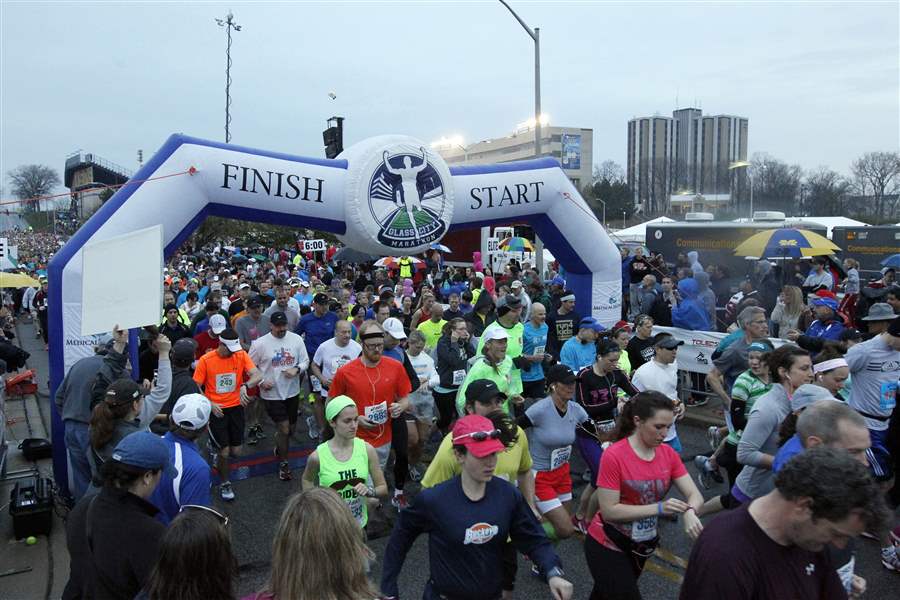
Director saw room to grow Glass City Marathon events
Participation accelerated with half-marathon’s addition
4/22/2014
Runners begin the the 2013 Medical Mutual Glass City Marathon at The University Of Toledo in April, 2013.
THE BLADE
Buy This Image
Clint McCormick is running down a dream.
The director of the Medical Mutual Glass City Marathon has seen participation in the annual event increase by nearly 500 percent since he took over in 2009.
More than 7,000 runners have signed up to compete in the 38th annual Glass City Marathon on Sunday. The economic impact associated with the event has mirrored the dramatic rise in the participation in the marathon.
The event brought $600,000 to the local economy last April, according to a study conducted by the University of Toledo.
An avid runner himself, McCormick said the goal one day is to bring in more than a million dollars to the community.
“It's exciting to see the impact it has had,” McCormick said. “It’s humbling to have contributed to that. It is fun to do.”
The event that starts and finishes on the campus of the University of Toledo includes a marathon, half-marathon, five-person marathon relay, and 5K.
“There is something for everyone in the community,” he said. “You can have a 2-year-old up to 90 years old.”
Participation has risen from 1,500 in 2009 to 5,500 in 2012. Last year, a record 6,500 runners took part in the event.
McCormick, whose day job is an account manager with the Internet company Toast Net, said he had served as a volunteer before taking over as the director in 2009. He said he would rather “skate under the radar.”
“I am a runner, and I understand what the runners want and the operations it takes,” he said. “When I took over, I thought one day we could get 10,000 people.”
The marathon, half-marathon, and relay start at 7:02 a.m., and the 5K begins at 7:15.
This will be the fifth year that the marathon has followed UT’s park and bike trail. The 26.2-mile marathon course heads north into Ottawa Hills and through Sylvania’s Olander Park before finishing at the 50-yard line at the Glass Bowl.
The event’s 38 years have not been sequential. The marathon started in 1971 but broke from 1985 to 1989. It was reborn in 1990, and in previous years it was run with a downtown start and finish. The course wound through Toledo’s suburbs.
The year before it moved to UT, there were 700 runners. In 2010, the number grew to 3,000, then increased to 4,500 in 2011 and 5,500 in 2012.
McCormick said the main catalyst for the growth has been the addition of the half-marathon as a standalone event.
“It is the fastest growing in the last 10 years in the country,” he said.
Of the 7,000 runners, a total of 3,000 will participate in this year’s half-marathon.
McCormick said the popularity of the shorter event is because of its less intense nature.
“You can run a marathon maybe twice a year,” he said. “But the half-marathon does not punish you as hard, and it doesn’t take as long to train.”
McCormick said another component in the growth has been a general movement toward a healthy lifestyle.
“More people are getting into fitness, and their children are following in their footsteps,” he said.
He also said the Glass City event is unique because participation is affordable. The entry fees are tiered. The marathon’s entry fee is $70, while it costs $25 to run in the 5K.
“We are still one of the lowest cost events in the country,” McCormick said.
He said the race attracts people from out of town, and many former residents return to northwest Ohio.
“It’s a reason to come back and visit with family,” he said.
Runners from 38 states and from as far away as China are participating this year. He said there also are large contingents from Hawaii and Canada.
“It creates tourism for Toledo,” McCormick said.
A study completed by the University of Toledo in 2013 concluded that the marathon generated more than $600,000 for the local economy.
“That is a pretty big impact. This is all new money coming to the area that wouldn’t have been here,” McCormick said.
The study conducted by Dr. Olugbenga Ajilore estimated the total impact accounted for $632,632 in increased economic activity.
“This marathon is becoming more and more popular, and we should expect to see continued increases in participation. … We will continue to see greater economic activity in the northwest Ohio region from the Medical Mutual Glass City Marathon,” Ajilore wrote in the study’s conclusion.
The largest impacts came from food and beverage purchases ($262,520) and lodging ($146,749).
Last year the marathon took place just days after the bombings at the Boston Marathon that took the lives of three people.
“Last year we had a significant increase in security,” McCormick said.
He said previous measures focused on parking enforcement and traffic control.
The scale of the marathon requires law enforcement officials from six jurisdictions: The University of Toledo, city of Toledo, Ottawa Hills, Sylvania Township, city of Sylvania, and Metroparks of the Toledo Area.
“We have asset protection plans in place,” McCormick said. “There are a lot of things we’ve done behind the scenes to elevate the communications [between the different law enforcement agencies].”
The most visible difference in security this year will be a change to the bag drop policy. All runners must use clear plastic bags to store their belongings while they race.
“The purpose is that it is easier for security to verify the contents in the bag,” he said.
He said plans also are in place for potential injuries to runners or weather incidents. Mobile police cameras also will be deployed.
“There will be a police presence,” he said. “We’re working together to figure out how we will respond.”
Contact Mark Monroe at: mmonroe@theblade.com, 419-724-6354 or on Twitter @MonroeBlade.